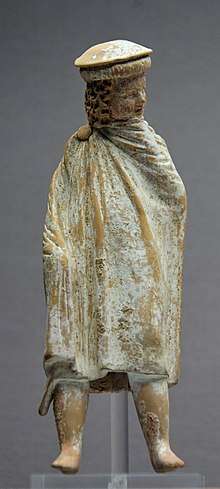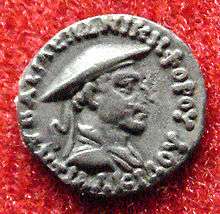Kausia
 |
 |
| Two 4th and 3rd century BC terracotta statues from Athens depicting ancient Macedonians wearing the kausia. | |

The kausia (Ancient Greek: καυσία[1]) was an ancient Macedonian flat hat.
It was worn during the Hellenistic period but perhaps even before the time of Alexander the Great[2] and was later used as a protection against the sun by the poorer classes in Rome.[3]
Depictions of the kausia can be found on a variety of coins and statues found from the Mediterranean to the Greco-Bactrian kingdom and the Indo-Greeks in northwestern India. The Persians referred to the Macedonians as Yaunã Takabara or "Greeks ('Ionians') with hats that look like shields", possibly referring to the Macedonian kausia hat.[4] According to Bonnie Kingsley the kausia may have came to the Mediterranean as a campaign hat worn by Alexander and veterans of his campaigns in India[5] but according to Ernst Fredricksmeyer the kausia was too established a staple of the Macedonian wardrobe for it to have been imported from Asia to Macedonia.[6]
A modern descendant of the hat may be the Pakol: the familiar and remarkably similar men's hat from Afghanistan and Pakistan.[7]

See also
References
- ↑ καυσία, Henry George Liddell, Robert Scott, A Greek-English Lexicon, on Perseus
- ↑ "The Kausia Diadematophoros", American Journal of Archaeology, 1984, on JSTOR
- ↑ "Miles gloriosus", Harvard University Press, 1997, on Google books
- ↑ Roisman, Joseph; Worthington, Ian (2010). A Companion to Ancient Macedonia. John Wiley and Sons. ISBN 1-4051-7936-8, p.87
- ↑ Kingsley, Bonnie M (1981). ""The Cap That Survived Alexander."". American Journal of Archaeology. 85: 39.
- ↑ Fredricksmeyer, Ernst (1986). "Alexander the Great and the Macedonian kausia". Transactions and Proceedings of the American Philological Association. 116: 215–227.
- ↑ Ian Worthington, Nicholas Geoffrey Lemprière Hammond, Ventures into Greek history, p. 135, Clarendon Press, 1994
- ↑ Olga Palagia (2000). "Hephaestion’s Pyre and the Royal Hunt of Alexander," in A.B. Bosworth and E.J. Baynham (eds), Alexander the Great in Fact and Fiction. Oxford & New York: Oxford University Press. ISBN 9780198152873, p. 185.
| Wikimedia Commons has media related to Kausia. |